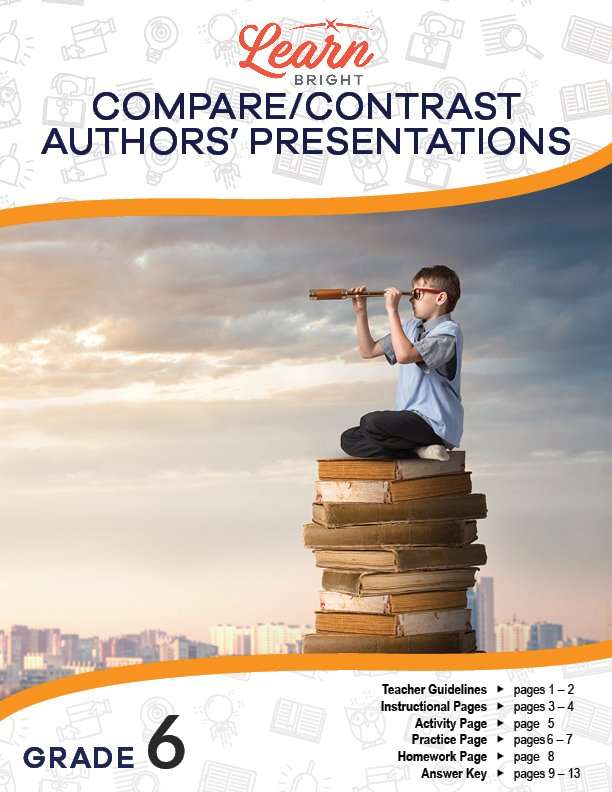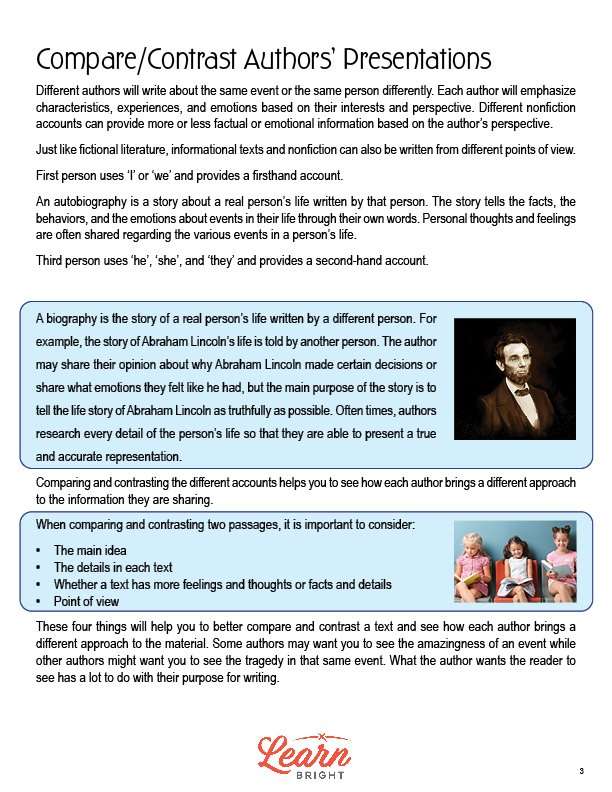Description
What our Compare/Contrast Authors’ Presentations lesson plan includes
Lesson Objectives and Overview: Compare/Contrast Authors’ Presentations teaches students how to compare and contrast different versions of the same event based on the author’s perspective. At the end of the lesson, students will be able to compare and contrast one author’s presentation of events with that of another. This lesson is for students in 6th grade.
Classroom Procedure
Every lesson plan provides you with a classroom procedure page that outlines a step-by-step guide to follow. You do not have to follow the guide exactly. The guide helps you organize the lesson and details when to hand out worksheets. It also lists information in the yellow box that you might find useful. You will find the lesson objectives, state standards, and number of class sessions the lesson should take to complete in this area. In addition, it describes the supplies you will need as well as what and how you need to prepare beforehand. To prepare for this lesson ahead of time, you can copy the handouts.
Options for Lesson
Included with this lesson is an “Options for Lesson” section that lists a number of suggestions for activities to add to the lesson or substitutions for the ones already in the lesson. One optional addition to this lesson is to have students use a Venn diagram or other organization tool to compare and contrast two pieces of literature. You can also have students interview each other about an event in their lives and have each of them write about the event, with one student taking on the role of the biographer and the other taking on the role of an autobiographer.
Teacher Notes
The teacher notes page includes a paragraph with additional guidelines and things to think about as you begin to plan your lesson. This page also includes lines that you can use to add your own notes as you’re preparing for this lesson.
COMPARE/CONTRAST AUTHORS’ PRESENTATIONS LESSON PLAN CONTENT PAGES
Compare/Contrast Authors’ Presentations
The Compare/Contrast Authors’ Presentations lesson plan includes two pages of content. The lesson begins by reminding students that different authors write about the same things in different ways, emphasizing characteristics or experiences based on their own interests and perspectives. We can also write informational and nonfiction texts from different points of view. First person accounts use “I” and “we,” while third person uses “he,” “she,” and “they” for a secondhand account.
Autobiographies are stories about real people’s lives written by that person. They tell the facts, behaviors, and emotions of different events in their life using their own words. They often share personal thoughts and feelings about these events.
Biographies are stories about real people’s lives written by a different person. For example, many people have written biographies about Abraham Lincoln’s life. Each author shares their own opinions about why he made the decisions he made or what emotions he may have been feeling, but they’re mainly aiming to tell the story of his life in a truthful way. This can involved lots and lots of research.
You can compare and contrast different account of a single person’s life to help you understand how each author has a different perspective on the information. When you compare and contrast, you should remember to think about the main idea, the details in the texts, if a text has more feelings or thoughts than facts or details, and the point of view.
Keeping these four things in mind will help you compare and contrast effectively. Different authors want their readers to see or understand different things about an event or person’s life, and this will affect how they write.
An Example
The lesson then dives into an example. You might tell a friend about your summer vacation and include lots of personal feelings. Firsthand accounts can be very opinionated. However, if someone else wrote about your vacation, that is a secondhand account. They want to inform people about the facts. While the firsthand account will include feelings and emotions, the secondhand account will be more specific about things like facts and dates. If you compare and contrast these two accounts, you will understand more about the events than if you just read one of them.
Comparing and contrasting will help you form a well-rounded image of an event of person. You should think through some questions while comparing and contrasting. Ask yourself: What is each author’s purpose for writing? Is the text a firsthand or secondhand account? Which details are in both accounts? Which details are in only one account? Do the two accounts conflict with each other? If so, what might be the cause of the conflict?
COMPARE/CONTRAST AUTHORS’ PRESENTATIONS LESSON PLAN WORKSHEETS
The Compare/Contrast Authors’ Presentations lesson plan includes three worksheets: an activity worksheet, a practice worksheet, and a homework assignment. You can refer to the guide on the classroom procedure page to determine when to hand out each worksheet.
BIOGRAPHY ACTIVITY WORKSHEET
For the activity worksheet, students will read a short biography of a famous person and will then write a diary entry from their perspective. They can find a biography to use at the site listed on the worksheet.
TWO PASSAGES PRACTICE WORKSHEET
The practice worksheet asks students to read two passages and and list two things the passages have in common and two things that are different. They will also determine which point of view each passage is written from and what type of literature each would likely appear in.
COMPARE/CONTRAST AUTHORS’ PRESENTATIONS HOMEWORK ASSIGNMENT
Like the practice worksheet, for the homework assignment, students will read two passages and will then list two things the passages have in common and two things that are different, in addition to determining which point of view each passage is written from.
Worksheet Answer Keys
This lesson plan includes answer keys for the practice worksheet and the homework assignment. If you choose to administer the lesson pages to your students via PDF, you will need to save a new file that omits these pages. Otherwise, you can simply print out the applicable pages and keep these as reference for yourself when grading assignments.









